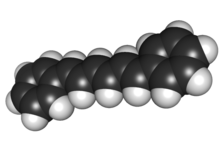Chemistry:Diphenylhexatriene
From HandWiki

| |

| |
| Names | |
|---|---|
| Preferred IUPAC name
1,1′-[(1E,3E,5E)-Hexa-1,3,5-triene-1,6-diyl]dibenzene | |
| Other names
(1E,3E,5E)-1,6-Diphenylhexa-1,3,5-triene
[(1E,3E,5E)-6-Phenylhexa-1,3,5-trien-1-yl]benzene trans,trans,trans-1,6-Diphenylhexatriene Dicinnamyl | |
| Identifiers | |
3D model (JSmol)
|
|
| ChEBI | |
| EC Number |
|
PubChem CID
|
|
| UNII | |
| |
| |
| Properties | |
| C18H16 | |
| Molar mass | 232.326 g·mol−1 |
| Melting point | 199 to 203 °C (390 to 397 °F; 472 to 476 K) |
| -146.9·10−6 cm3/mol | |
| Hazards | |
| GHS pictograms | 
|
| GHS Signal word | Warning |
| H315, H319, H335 | |
| P261, P264, P271, P280, P302+352, P304+340, P305+351+338, P312, P332+313, P337+313, P362, P403+233, P405, P501 | |
Except where otherwise noted, data are given for materials in their standard state (at 25 °C [77 °F], 100 kPa). | |
| Infobox references | |
Diphenylhexatriene is a fluorescent hydrocarbon used in the study of cell membranes. It is almost non-fluorescent in water, but it exhibits strong fluorescence when it is intercalated into lipid membranes. It incorporates itself into the lipid bilayer and acts like a lipid. [3][4]
References
- ↑ 1,6-Diphenyl-1,3,5-hexatriene at Sigma-Aldrich
- ↑ "1,6-Diphenyl-1,3,5-hexatriene" (in en). https://pubchem.ncbi.nlm.nih.gov/compound/5376733#section=Safety-and-Hazards.
- ↑ trans-trans-trans-1,6-Diphenyl-1,3,5-hexatriene , Molecule of the Week, American Chemical Society, December 8, 2008
- ↑ Litman, B; Barenholz, Y (1982). "[91] Fluorescent probe: Diphenylhexatriene". Biomembranes - Part H: Visual Pigments and Purple Membranes - I. Methods in Enzymology. 81. pp. 678–85. doi:10.1016/S0076-6879(82)81093-8. ISBN 978-0-12-181981-1.
External links
- 1,6-Diphenylhexatriene, Oregon Medical Laser Center
 |

